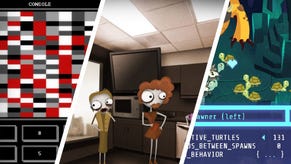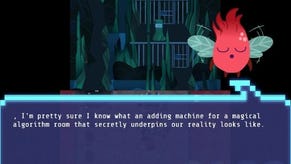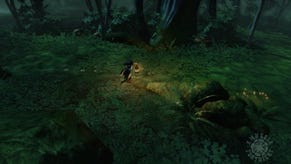Hack 'N' Slash: Wot I Think
C+
Double Fine's devious hacking/programming action puzzler Hack 'N' Slash is now out of Early Access and into Version 1.0. I've run around jabbing USB sticks into ports all over the place, until I hit a wall of complexity I couldn't find the will to pass. Here's wot I think:
I am daunted by Hack ‘N’ Slash. I was daunted before I started playing, having seen the game running at an event at GDC this year, in which it was shown just how hackable this top-down puzzle game truly is. I find it daunting when the edges of things aren’t defined – it destabilises my sense of a game, and so a game in which you redefine the properties of its own contents in order to solve challenges doesn't only sound amazing. It sounds daunting.
Hack ‘N’ Slash is clearly expecting that in a player. While it certainly doesn’t go to any lengths to over-explain itself, or spoil the magic of its own meta-nature by including a frame-breaking-breaking tutorial, it introduces the concept carefully.
You are a Link-like videogame character, and your sword is a USB stick. Whack it into baddies, objects, anything with a USB port, and you can reprogram fixed values to change the nature or behaviour. If there’s a rock in your way and it won’t budge, hack it and tell it that it has so many moves left, moves so many tiles when shoved, the speed it moves, and so on. Maybe that rock doesn’t have room to move forward, so program it to move -1 tile when it’s pushed, then dodge out of the way as it comes toward you after a shove. When there’s a baddy bird pecking you, how about hacking it so it carries on attacking, but its pecks do -2 points of damage?
It’s packed with such smart ideas, and it doesn’t rest on one for too long. Soon after you’re used to the hacking sword, it changes things up with a magic hat that lets you see the ‘Matrix’. Guard idle routines become something you can manipulate, and then time itself. And throughout, it’s being smart about itself, too. Infinite woods are a trope going back as far as gaming itself – impossibly looping labyrinths appeared in the earliest text adventures – and here they appear as a piece of technical wizardry that scares my eyes. No matter how much you walk around, the game is always zooming in on you, and yet the view never gets any closer. It’s like a reverse Hitchcock dolly zoom that goes on for, well, infinity.
Gosh, I love it at a conceptual level. But boy I get overwhelmed each time I look at a long screen of variables for an enemy, and start worrying the game’s about to want me to have a degree in something other than youth work and applied theology. When the screen becomes filled with its data made visual, text floating above objects, parameter lines projected over the art, I worry it’s about to get too tough. And yet, as I solve each puzzle, as I progress, I realise it’s not the challenges that are daunting me, it’s not the hacking, the variables, the complexity. It’s the sense of aimlessness.
It’s just a bit too loose. It’s not the smartness, nor the complexity, that is giving me this undercurrent of alienation. It’s a woolliness. Too many directions open up at any time, too many of them just dead ends. Too often am I solving puzzles because there’s a puzzle in front of me, rather than because I have any idea how it’s going to affect anything. And while it’s a game that wants me to fiddle under its illusion of a bonnet, it throws so many tools at me so quickly that I’ve often felt fatigue rather than intrigue.
But then again, I’ve also felt super-smart. When games shout, “THANK GOODNESS, THE GREATEST GENIUS-O-HERO OF OUR TIME!” because you hit a rat on the forehead, it feels deeply patronising. When Hack ‘N’ Slash congratulates you on having demonstrated great cleverness, well, you have. Admittedly it’s an artificial clever, but I’m owning that, thanks.
And then, four acts in, it lives up to my initial fear, and suddenly splurges a whole new set of rules on you with impenetrable explanation. The wonderful world of programming. Firstly, the explanations only appear once, and secondly, they’re so packed with irrelevant jokes that noticing what you actually need to fathom is a real pain. Thirdly, they’re terrible explanations. You’re trying to program the code behind the ports you’ve previously been hacking, following various logic gates and so forth, but it’s so esoteric, and so poorly elucidated, that I was immediately frustrated. Yes, those who have an instinct for such things will be pointing out it was literally “2+2=4”, but getting to that point requires some sizable leaps of understanding. Get it wrong, and you’ll likely break the game on such a level that it has to “crash” itself and restart the level. And that is nothing compared to what’s to come.
Where once Hack ‘N’ Slash rather sweetly created the artifice of being able to hack elements of itself in order to solve top-down exploration puzzles, in its fourth act it’s requiring that you reprogram its code in a way completely unsuited to top-down exploration. Changing a value involves running around, hacking nodes inside machines, and trying to follow its obtuse design rather than just typing it with your keyboard. And its deliberate obfuscation for those not familiar with programming begins to feel a touch less enchanting each time the characters shrug their shoulders and say they don’t understand it either.
I think the largest issue is it moves too fast. At the start, that’s fine, although a little strange. It gives you tools, teaches you to use them, and then abandons them. But by the later stages, this accelerated rate becomes overwhelming. I’d barely got to grips with the programming aspects, when it suddenly throws out the most convoluted, elaborate one yet, and then reveals that I need to go yet another programming step deeper before I can try to fathom it... and I just feel that daunt.
Clearly that’s not going to be applicable to many other people, who will be delighted to hear that it reaches a place of such fiddly difficulty. My argument is that I might well have equally enjoyed these moments if there were some notion of a difficulty curve to reach them, rather than the difficulty staircase it seems to have employed.
It all looks wonderful, and the characters are all completely lovely and often hilarious. The concepts are brilliant, deserving the gasps they received at that GDC conference as much now as then. While there are still typos left in, it’s mostly superbly written.
It’s also pretty clumsy. Why you’re limited to just five assigned buttons for inventory items (whether on keyboard or controller) is mystifying – and infuriating, since the only way to use an item is to assign it a shortcut you’re already using for something else. Also, the top-down angle is just skewiff enough that it’s far too easy to fall off the edges of things. I’m also not at all sure why rooms reset when you re-enter them – it never seems to be important for the way the game works, and mostly serves to be an irritant, forcing you to repeat the same mundane tasks.
However, this is still a game where you can figure out how to hack your own character to increase your movement speed, should you dig deep enough. Or simply amuse yourself reprogramming a roomful of guards to attack each other. It’s enormously clever, and very often inspired in how it delivers this cleverness. But for me it was simply too fast, too busy stumbling over itself to do the next even more difficult thing, that it forgot to ensure I’d fathomed the previous. Perhaps I’m Captain Thicko of the Ship Great Big Thickoface, and you should take this as a strong recommendation to pick up a game that Thicky Walker found too hard.
Hack 'N' Slash is currently £10 on Steam.











